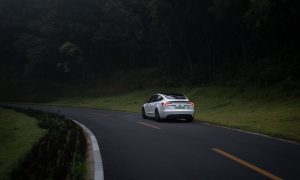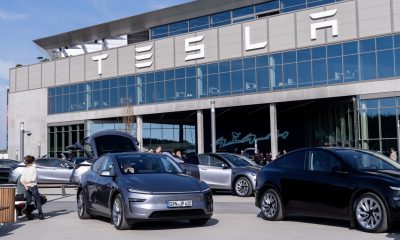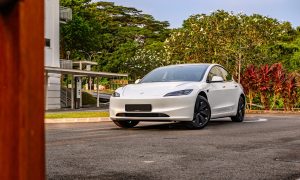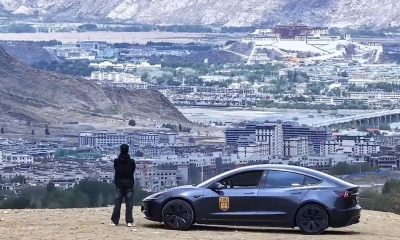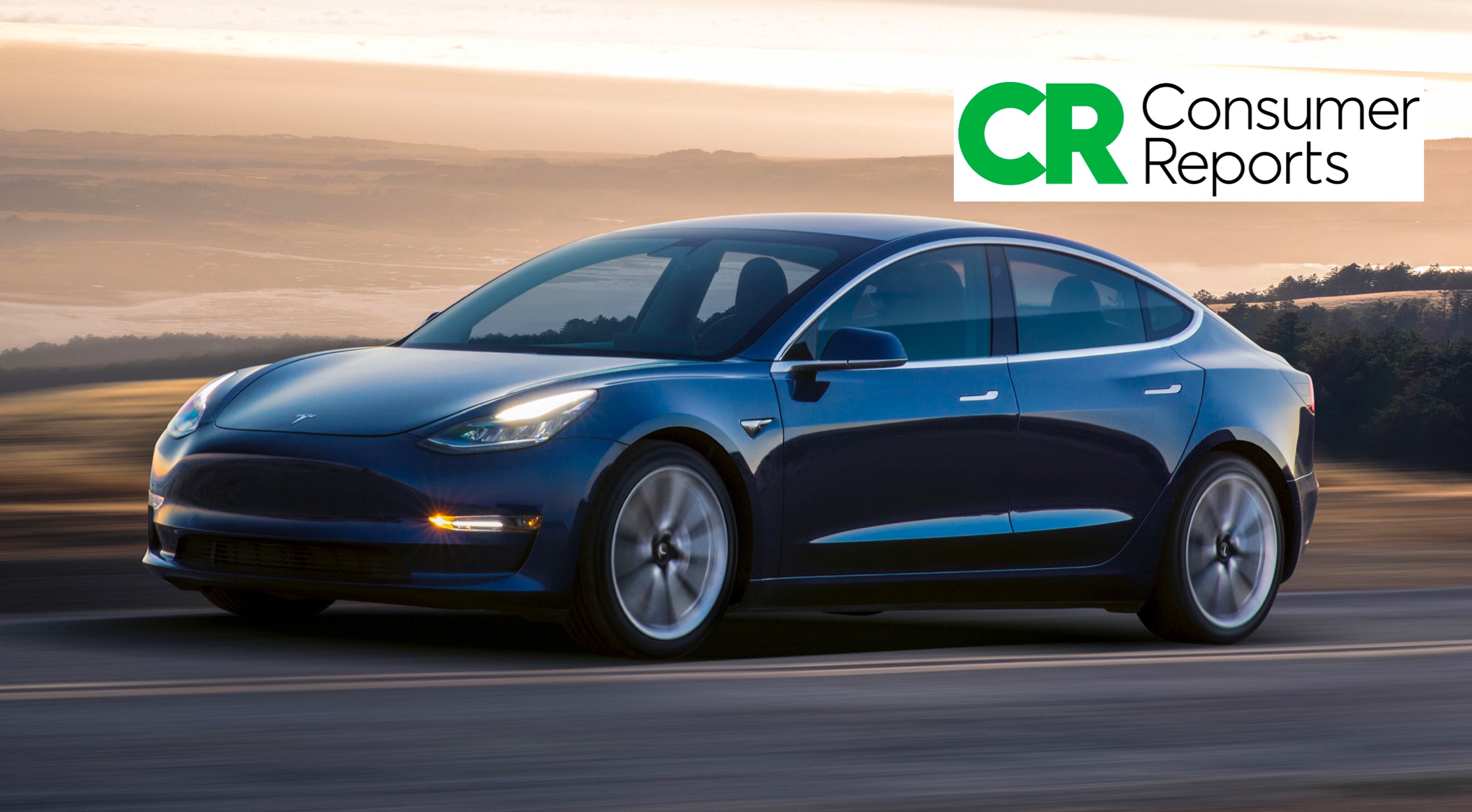

News
CR responds to Tesla over claims that its reviews are inaccurate and misleading
Consumer Reports has fired back at Tesla, issuing a statement that defends its recent report that predicts Model 3 to have “average reliability”. “Tesla appears unhappy that CR expects the new-to-market Tesla Model 3 to be of average reliability, which is generally a positive projection for any first model year of a car.” says CR in a press release sent to Teslarati.
The nonprofit organization that aims to educate consumers on the value of product, that can be anywhere from a household vacuum cleaner to an automobile, through its product testing reinforces its methodology for making predictions. “Here’s how we make the prediction” notes CR, addressing Tesla’s claim that the organization’s “automotive reporting is consistently inaccurate and misleading to consumers”.
“CR uses survey data it receives from car owners to predict the expected reliability of new cars being introduced to the market by looking across a manufacturer’s historic results (akin to how a weather forecaster predicts it will be sunny) — separate from the hands-on road tests we use for our overall score.” reads the press release.
The organization provides further reasoning for the predicted reliability rating assigned to Tesla’s latest mass market vehicle. “For the Model 3, we looked at more than 2,000 consumer survey responses about Tesla models. In fact, the Tesla Model S is now reported as having above average reliability for the first time ever. The Tesla Model S is also currently CR’s top rated car, period. (Kudos on both, Tesla!)”
We’ve provided the full press release from Consumer Reports below. Let us know what your thoughts are in the comments section.
CONSUMER REPORTS RESPONDS TO TESLA’S COMPLAINTS ON REPORTING, RESEARCH AND REVIEWS
Late yesterday, Tesla shared with select journalists what appears to have been a prepared statement of supercharged and unsupported claims about the performance and safety of their own vehicles and our 2017 Annual Reliability Survey results, taking the occasion to air a number of grievances against Consumer Reports (CR) and our overall reporting on Tesla and its products.
As is often the result of any new product or company that electrifies the market, Tesla does garner an outsized level of attention, scrutiny and discussion by the media. While we appreciate Tesla’s efforts to typically embrace and navigate, if not directly steer, this attention, we would like to offer some clarity on the examples they cite. (For other, perhaps not surprisingly Tesla-positive, examples from CR, you can visit the articles currently available at the Tesla press site, at least until they pull those links down, or visit us at CR.org).
Tesla seems to misunderstand or is conflating some of what we fundamentally do — our Annual Reliability Survey report and the related predictions versus our car reviews and tests.
First, Tesla appears unhappy that CR expects the new-to-market Tesla Model 3 to be of average reliability, which is generally a positive projection for any first model year of a car. This expectation is based on CR’s 2017 Annual Reliability Survey, measuring the dependability as opposed to the satisfaction, of more than 300 car models, model year 2000 to 2017, using the responses of individual owners of more than 640,000 vehicles. We provide this information to help people make informed purchasing decisions as new products reach the market.
Here’s how we make the prediction: CR uses survey data it receives from car owners to predict the expected reliability of new cars being introduced to the market by looking across a manufacturer’s historic results (akin to how a weather forecaster predicts it will be sunny) — separate from the hands-on road tests we use for our overall score.
For the Model 3, we looked at more than 2,000 consumer survey responses about Tesla models. In fact, the Tesla Model S is now reported as having above average reliability for the first time ever. The Tesla Model S is also currently CR’s top rated car, period. (Kudos on both, Tesla!)
Second, Tesla has taken larger issue with how CR produces car ratings, citing specific examples where they think our testing methods fell short or were unfair. CR conducts a battery of 50 standardized tests across all the vehicles we review — we have a lot of mileage in this arena. We also continuously update our ratings as new surveys are conducted and we test the cars we purchase to reflect the current realities of what a consumer should expect in the marketplace. (That’s right, purchase. CR does not accept any advertising and purchases the products we rate like any other regular person.) The Model S rating has changed over time, going up and down, as new data becomes available.
Thanks to technological advances such as product changes delivered by an over-the-air software update and thereby adding or subtracting features, we reevaluate products to inform consumers about what to expect after any update. These changes are then reflected in our ratings. Tesla frequently updates its software in just this way, which is relatively unique in the automotive market, often resulting in material changes to its products and therefore our ratings — both positively and negatively. It also happens to drive more frequent press coverage given the need to communicate product changes to consumers.
While our reliability survey data feeds into the overall score we give any product,that is just one input. As with all the cars we review, you can rest assured that we will thoroughly test and evaluate the Model 3 with the same care and scrutiny we apply to all the cars we test just as soon as we can get one — we’re waiting patiently along with other consumers.
As an independent, nonprofit organization that works side-by-side with consumers to create a fairer, safer, and healthier world, CR provides trusted knowledge people depend on to make better, more informed choices. We conduct evidence-based product testing and ratings, rigorous research, hard-hitting investigative journalism, public education, and steadfast advocacy on behalf of consumers’ interests. Buying a car that has an average or above average score for predicted reliability will likely reduce the chances of having problems with the car.
We at CR are confident in our data, methods, and reporting — and the historic results we’ve achieved in improving consumer products, services, and the marketplace. We will continue to report on and test Tesla’s products in the same fair-minded, consumer-focused way we do with all manufacturers, to help shape products to best serve the needs of consumers.
News
Tesla launches in India with Model Y, showing pricing will be biggest challenge
Tesla finally got its Model Y launched in India, but it will surely come at a price for consumers.

Tesla has officially launched in India following years of delays, as it brought its Model Y to the market for the first time on Tuesday.
However, the launch showed that pricing is going to be its biggest challenge. The all-electric Model Y is priced significantly higher than in other major markets in which Tesla operates.
On Tuesday, Tesla’s Model Y went up for sale for 59,89,000 rupees for the Rear-Wheel Drive configuration, while the Long Range Rear-Wheel Drive was priced at 67,89,000.
This equates to $69,686 for the RWD and $78,994 for the Long Range RWD, a substantial markup compared to what these cars sell for in the United States.
🚨 Here’s the difference in price for the Tesla Model Y in the U.S. compared to India.
🚨 59,89,000 is $69,686
🚨 67,89,000 is $78,994 pic.twitter.com/7EUzyWLcED— TESLARATI (@Teslarati) July 15, 2025
Deliveries are currently scheduled for the third quarter, and it will be interesting to see how many units they can sell in the market at this price point.
The price includes tariffs and additional fees that are applied by the Indian government, which has aimed to work with foreign automakers to come to terms on lower duties that increase vehicle cost.
Tesla Model Y seen testing under wraps in India ahead of launch
There is a chance that these duties will be removed, which would create a more stable and affordable pricing model for Tesla in the future. President Trump and Indian Prime Minister Narendra Modi continue to iron out those details.
Maharashtra Chief Minister Devendra Fadnavis said to reporters outside the company’s new outlet in the region (via Reuters):
“In the future, we wish to see R&D and manufacturing done in India, and I am sure at an appropriate stage, Tesla will think about it.”
It appears to be eerily similar to the same “game of chicken” Tesla played with Indian government officials for the past few years. Tesla has always wanted to enter India, but was unable to do so due to these import duties.
India wanted Tesla to commit to building a Gigafactory in the country, but Tesla wanted to test demand first.
It seems this could be that demand test, and the duties are going to have a significant impact on what demand will actually be.
Elon Musk
Tesla ups Robotaxi fare price to another comical figure with service area expansion
Tesla upped its fare price for a Robotaxi ride from $4.20 to, you guessed it, $6.90.

Tesla has upped its fare price for the Robotaxi platform in Austin for the first time since its launch on June 22. The increase came on the same day that Tesla expanded its Service Area for the Robotaxi ride-hailing service, offering rides to a broader portion of the city.
The price is up from $4.20, a figure that many Tesla fans will find amusing, considering CEO Elon Musk has used that number, as well as ’69,’ as a light-hearted attempt at comedy over the past several years.
Musk confirmed yesterday that Tesla would up the price per ride from that $4.20 point to $6.90. Are we really surprised that is what the company decided on, as the expansion of the Service Area also took effect on Monday?
But the price is now a princely $6.90, as foretold in the prophecy 😂
— Elon Musk (@elonmusk) July 14, 2025
The Service Area expansion was also somewhat of a joke too, especially considering the shape of the new region where the driverless service can travel.
I wrote yesterday about how it might be funny, but in reality, it is more of a message to competitors that Tesla can expand in Austin wherever it wants at any time.
Tesla’s Robotaxi expansion wasn’t a joke, it was a warning to competitors
It was only a matter of time before the Robotaxi platform would subject riders to a higher, flat fee for a ride. This is primarily due to two reasons: the size of the access program is increasing, and, more importantly, the service area is expanding in size.
Tesla has already surpassed Waymo in Austin in terms of its service area, which is roughly five square miles larger. Waymo launched driverless rides to the public back in March, while Tesla’s just became available to a small group in June. Tesla has already expanded it, allowing new members to hail a ride from a driverless Model Y nearly every day.
The Robotaxi app is also becoming more robust as Tesla is adding new features with updates. It has already been updated on two occasions, with the most recent improvements being rolled out yesterday.
Tesla updates Robotaxi app with several big changes, including wider service area
News
Tesla Model Y and Model 3 dominate U.S. EV sales despite headwinds
Tesla’s two mainstream vehicles accounted for more than 40% of all EVs sold in the United States in Q2 2025.

Tesla’s Model Y and Model 3 remained the top-selling electric vehicles in the U.S. during Q2 2025, even as the broader EV market dipped 6.3% year-over-year.
The Model Y logged 86,120 units sold, followed by the Model 3 at 48,803. This means that Tesla’s two mainstream vehicles accounted for 43% of all EVs sold in the United States during the second quarter, as per data from Cox Automotive.
Tesla leads amid tax credit uncertainty and a tough first half
Tesla’s performance in Q2 is notable given a series of hurdles earlier in the year. The company temporarily paused Model Y deliveries in Q1 as it transitioned to the production of the new Model Y, and its retail presence was hit by protests and vandalism tied to political backlash against CEO Elon Musk. The fallout carried into Q2, yet Tesla’s two mass-market vehicles still outsold the next eight EVs combined.
Q2 marked just the third-ever YoY decline in quarterly EV sales, totaling 310,839 units. Electric vehicle sales, however, were still up 4.9% from Q1 and reached a record 607,089 units in the first half of 2025. Analysts also expect a surge in Q3 as buyers rush to qualify for federal EV tax credits before they expire on October 1, Cox Automotive noted in a post.
Legacy rivals gain ground, but Tesla holds its commanding lead
General Motors more than doubled its EV volume in the first half of 2025, selling over 78,000 units and boosting its EV market share to 12.9%. Chevrolet became the second-best-selling EV brand, pushing GM past Ford and Hyundai. Tesla, however, still retained a commanding 44.7% electric vehicle market share despite a 12% drop in in Q2 revenue, following a decline of almost 9% in Q1.
Incentives reached record highs in Q2, averaging 14.8% of transaction prices, roughly $8,500 per vehicle. As government support winds down, the used EV market is also gaining momentum, with over 100,000 used EVs sold in Q2.
Q2 2025 Kelley Blue Book EV Sales Report by Simon Alvarez on Scribd
-

 News3 days ago
News3 days agoTesla debuts hands-free Grok AI with update 2025.26: What you need to know
-

 Elon Musk1 week ago
Elon Musk1 week agoElon Musk confirms Grok 4 launch on July 9 with livestream event
-

 Elon Musk5 days ago
Elon Musk5 days agoxAI launches Grok 4 with new $300/month SuperGrok Heavy subscription
-

 News2 weeks ago
News2 weeks agoTesla Model 3 ranks as the safest new car in Europe for 2025, per Euro NCAP tests
-

 Elon Musk2 weeks ago
Elon Musk2 weeks agoxAI’s Memphis data center receives air permit despite community criticism
-

 News5 days ago
News5 days agoTesla begins Robotaxi certification push in Arizona: report
-

 Elon Musk2 weeks ago
Elon Musk2 weeks agoTesla reveals it is using AI to make factories more sustainable: here’s how
-

 Elon Musk2 weeks ago
Elon Musk2 weeks agoTesla scrambles after Musk sidekick exit, CEO takes over sales


